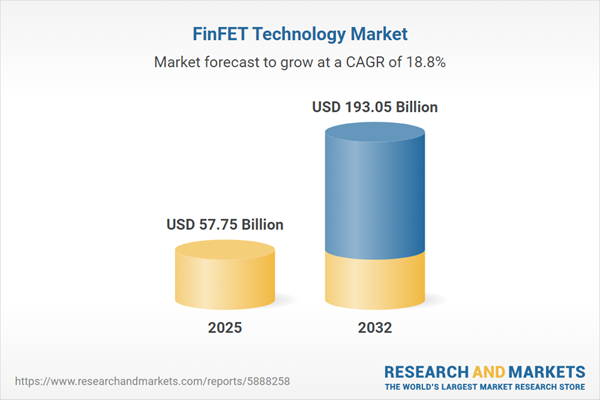Speak directly to the analyst to clarify any post sales queries you may have.
FinFET technology is redefining semiconductor innovation, ushering in sophisticated three-dimensional transistor architectures that drive superior performance and power efficiency across key applications. The accelerating shift to advanced nodes continues to shape technology strategies for global business leaders seeking a sustainable competitive advantage in electronics.
Market Snapshot: FinFET Technology Market Growth & Outlook
The FinFET Technology Market grew from USD 48.50 billion in 2024 to USD 57.75 billion in 2025, and is forecast to expand at a compound annual growth rate (CAGR) of 18.84%, reaching USD 193.05 billion by 2032. This consistent growth reflects evolving demand for efficient and scalable semiconductor solutions across diverse sectors.
Scope & Segmentation: Technology Use Cases and Regional Analysis
The report comprehensively examines the FinFET Technology Market across the following segments and regions:
- Process Nodes: 1.4 nm, 2 nm, 3 nm, 5 nm, 7 nm, 10 nm, 14 nm, 28 nm
- Device Types: Automotive (including Advanced Driver Assistance Systems, Autonomous Vehicles, Infotainment), Consumer Electronics (AR/VR Headsets, Digital Cameras, Gaming Consoles, Smart TVs), High Performance Computing (Data Center, Quantum Computing, Server), Internet of Things (Consumer IoT, Industrial IoT, Smart Home Devices), Mobile (Foldables, Smartphones, Tablets, Wearables)
- Applications: AI and Machine Learning (Data Center AI, Edge AI, Neuromorphic Computing), Automotive Electronics (Engine Control Units, Infotainment Systems, Lidar Systems), Networking and Telecom (5G and 6G Infrastructure, Routers, Switches), Smartphones (Budget, High-End, Mid-Range), Wearables (AR Glasses, Fitness Trackers, Smartwatches)
- Wafer Sizes: 200 mm, 300 mm, 450 mm
- Regions Covered: Americas (United States, Canada, Mexico, Brazil, Argentina, Chile, Colombia, Peru), Europe, Middle East & Africa (United Kingdom, Germany, France, Russia, Italy, Spain, Netherlands, Sweden, Poland, Switzerland, UAE, Saudi Arabia, Qatar, Turkey, Israel, South Africa, Nigeria, Egypt, Kenya), Asia-Pacific (China, India, Japan, Australia, South Korea, Indonesia, Thailand, Malaysia, Singapore, Taiwan)
- Key Companies Analyzed: Taiwan Semiconductor Manufacturing Company Limited, Samsung Electronics Co., Ltd., Intel Corporation, GlobalFoundries Inc., Semiconductor Manufacturing International Corporation
Key Takeaways for Senior Decision-Makers
- FinFET architectures have enabled significant advances in computational power and energy reduction for devices ranging from mobile processors to artificial intelligence accelerators.
- Continued process node shrinkage is fostering new device varieties and driving innovation in materials and manufacturing technologies.
- The industry is prioritizing versatile platform development to fulfill both performance and low-power needs across automotive, data center, IoT, and consumer electronics sectors.
- Supply chain resilience has become paramount, prompting stakeholders to diversify sources and invest in greater material traceability and digital visibility.
- Collaborative business models, public-private partnerships, and vertical integration strategies are redefining R&D cost structures and accelerating time to market for next-generation semiconductor products.
Tariff Impact: Managing Disruption & Building Supply Chain Resilience
The imposition of tariffs in 2025 has elevated the complexity of semiconductor supply chains, particularly for advanced FinFET manufacturing. Tariffs have increased costs for essential inputs, leading organizations to adopt inventory and sourcing adjustments while exploring regionalized manufacturing options. Governments across Asia-Pacific and Europe are providing new incentives to attract semiconductor investments, further encouraging diversification and resilience in production strategies.
Methodology & Data Sources
This executive analysis is based on extensive primary research, including interviews with semiconductor executives and technology specialists, as well as comprehensive secondary research from technical white papers, regulatory filings, and academic collaborations. Data triangulation and expert panel validations ensure accuracy and actionable insights.
Why This Report Matters for Leadership Strategy
- Enables strategic planning by clarifying which segments and technologies present the highest near-term and long-term value across global markets.
- Equips executive teams to anticipate supply chain risks and regulatory impacts, informing robust operational and R&D strategies for a fast-changing market.
- Supports informed investment and partnership decisions through detailed competitive analysis and future-ready technology roadmaps.
Conclusion
The FinFET Technology Market is evolving rapidly, driven by innovation in design, manufacturing, and ecosystem collaboration. Leaders who leverage insights from this analysis are well-positioned to capture emerging opportunities and strengthen their market presence in the global semiconductor landscape.
Additional Product Information:
- Purchase of this report includes 1 year online access with quarterly updates.
- This report can be updated on request. Please contact our Customer Experience team using the Ask a Question widget on our website.
Table of Contents
3. Executive Summary
4. Market Overview
7. Cumulative Impact of Artificial Intelligence 2025
Companies Mentioned
The companies profiled in this FinFET Technology market report include:- Taiwan Semiconductor Manufacturing Company Limited
- Samsung Electronics Co., Ltd.
- Intel Corporation
- GlobalFoundries Inc.
- Semiconductor Manufacturing International Corporation
Table Information
| Report Attribute | Details |
|---|---|
| No. of Pages | 190 |
| Published | October 2025 |
| Forecast Period | 2025 - 2032 |
| Estimated Market Value ( USD | $ 57.75 Billion |
| Forecasted Market Value ( USD | $ 193.05 Billion |
| Compound Annual Growth Rate | 18.8% |
| Regions Covered | Global |
| No. of Companies Mentioned | 6 |








